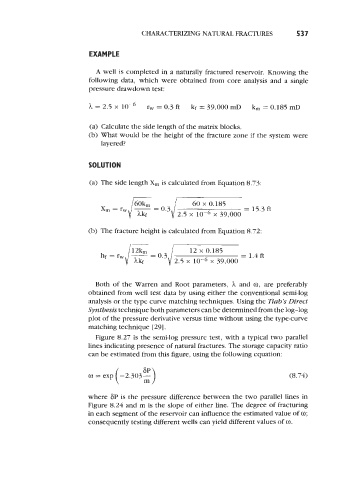Page 570 - Petrophysics
P. 570
CHARACTERIZING NATURAL. FRACTURES 537
EXAMPLE
A well is completed in a naturally fractured reservoir. Knowing the
following data, which were obtained from core analysis and a single
pressure drawdown test:
h = 2.5 x r, = 0.3 ft kf = 39,000 mD k, = 0.185 mD
(a) Calculate the side length of the matrix blocks.
(b) What would be the height of the fracture zone if the system were
layered?
SOLUTION
(a) The side length X, is calculated from Equation 8.73:
--
Xm=rw /F - o.3Jdou(llXs- = 15.3 ft
2.5 x x 39,000
(b) The fracture height is calculated from Equation 8.72:
Both of the Warren and Root parameters, h and a, are preferably
obtained from well test data by using either the conventional semi-log
analysis or the type curve matching techniques. Using the Tiub’s Direct
Synthesis technique both parameters can be determined from the log-log
plot of the pressure derivative versus time without using the typecurve
matching technique [29].
Figure 8.27 is the semi-log pressure test, with a typical two parallel
lines indicating presence of natural fractures. The storage capacity ratio
can be estimated from this figure, using the following equation:
o = exp (-2.303:) (8.74)
where 6P is the pressure difference between the two parallel lines in
Figure 8.24 and m is the slope of either line. The degree of fracturing
in each segment of the reservoir can influence the estimated value of O;
consequently testing different wells can yield diEferent values of 0.

